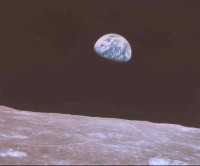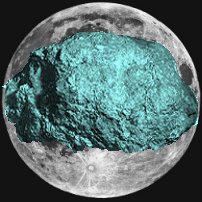Four billion years ago, when the Earth was but a mere babe nestled in the cradle of the solar accretion disc, the local environs were littered with asteroid-sized chunks of rock known as planetesimals. The Period of Heavy Bombardment, which lasted from about 4.5 to 3.8 billion years ago, saw the planetesimals colliding with the Earth on a daily basis. Not the gentlest of starts to life.
In October, delegates at Perspectives in Astrobiology, a NATO Advanced Studies Institute in Chania, Crete, heard how there is something anomalous about the end of the Period of Heavy Bombardment. We know from the fossil record that life has existed on Earth since around 3.8 billion years ago but how could it have survived and indeed thrived during the daily onslaught of the PHB?

Could the Moon harbour the secrets of life on Earth? (Credit: NASA)
Some astrobiologists believe those bombarding chunks of rock, or perhaps a comet, may have carried the seeds of life to Earth, explaining its origins during the PHB. Others wonder whether the rocky colliders simply deposited the raw materials, organic building blocks, ready for Earth’s seemingly special conditions to trigger the emergence of life. There is no clear answer yet.
Astrobiologists, however, think they now have a source of rock from that epoch that is truly out of this world and could allow them to study the molecular fossils from the dawn of time as well as revealing much about the wind and rain, earthquakes and plate tectonics on Earth at that time.

John Armstrong
But, where is this ancient record of Earth’s early days?

Guillermo Gonzalez
According to John Armstrong and Llyd Wells of the University of Washington and Guillermo Gonzalez at Iowa State University it is on the Moon.

A large Moon rock nicknamed Big Muley, weighing 11.7 kg. This rock was the largest returned to Earth by Apollo astronauts. (Credit: NASA)
All those repeated collisions had quite an impact on the Earth, flinging off great pieces of debris into space. 4.5 billion years ago, astronomers believe, the Moon itself was simply another piece of space debris, the original chip off the old block, trapped in Earth’s orbit after a particularly violent collision between Earth and a Mars-sized planetesimal. During the PHB plenty more debris was hewn from the Earth and would have been cleaned up by the Moon when it was much closer to the Earth than it is today, as it orbited the young Earth.
The lack of weather and plate tectonics on the Moon mean, much of that debris might still be lying still on the Moon’s surface. The researchers suggest that at least 20 tonnes of Earth material might cover every 100 square kilometre of the Moon’s surface. The Apollo missions brought back to Earth a mere fraction of the Moon’s surface rocks and soils, some 400 kg. Could there be some non-Lunar material in those samples? Armstrong reckons it is a possibility and that samples from the Moon’s eastern limb, as seen from Earth might be the place to look, because that would have likely gathered up the most debris from Earth’s orbit.
Spotting the chemical differences between true Moon rock and more recently acquired Earth debris on the Moon’s surface will be key to determining the original origin of a sample. The presence of hydrated minerals or hydrocarbons would be the first characteristics to investigate.
Further reading
John Armstrong
http://space.weber.edu/~jca/HomePage/John_Armstrong.html
Guillermo Gonzalez
http://www.public.iastate.edu/~astro/faculty/gonzalez.html
Suggested searches
Astrobiology
Lunar surface
Moon formation
Moon